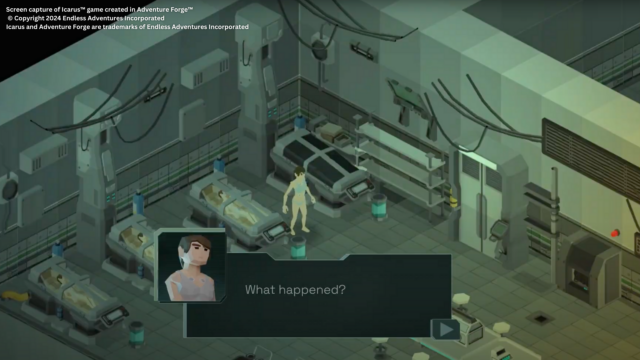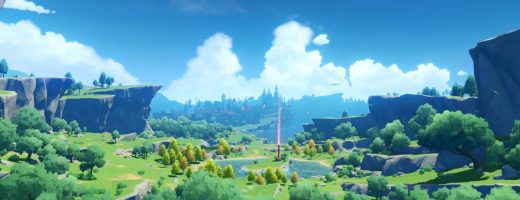Adventure Forge Preview
The way the tool is built looks ideal for working with the sort of narrative games that Jordan laid out during the presentation.
Game designer Jordan Weisman has covered extensive ground with his career in tabletop and video games. Highlights include the creation of the Shadowrun and BattleTech tabletop games and subsequent franchises, plus the founding of development studio Harebrained Schemes. His latest project turns to game creation tools themselves on Adventure Forge with the team at Endless Adventures Incorporated. Jordan gave RPGamer an overview of Adventure Forge, showing some of the examples created using it and talking about what’s coming as it undergoes its first public demo this week during Steam Next Fest.
Jordan states the goal of Adventure Forge is to empower more people with the capability of telling their stories through video games, partly inspired by the vast amount of stories that have been able to be told through tabletop games and RPGs. The tool utilises no-code tools and is primarily built to work with narrative games, but this grouping covers a broad variety of genres and presentations including text-based interactive fiction, visual novels, dating sims, hidden object games, point-and-click adventures, and deep isometric RPGs. The first example shown created by the tool is an internally-developed 30-minute sci-fi mystery called The Icarus Experiment, which sees players exploring a derelict spaceship while accessing computer systems and logs.
Games that the studio releases in Adventure Forge will not only be playable, but creators will be able to open them up, see how they have been created, and modify them. Adventure Forge will release with four separate “universes”, effectively large deposits of pre-built graphical assets that players can build from without needing to create their own assets right away. The Icarus Experiment uses one of these universes, while another title, Diary of the Dead, uses a modern-day setting to create a post-apocalyptic puzzle-based zombie adventure. A third settings offer a traditional fantasy world, while the fourth is a special setting based on a magical version of renaissance Venice, with the example title Tales of Fortunata demonstrating a mixture of isometric RPG and visual novel elements.
Explorative sections utilise an isometric view with 3D assets moving around on a 2D background, while another 2D-based tool can handle a wide variety of interactions, such as inputting a code into a lockbox, navigating a computer terminal, or moving around some books. Creators can even show elements like dice rolls on the screen. While it will come with its pre-built graphical assets, Adventure Forge is built to let creators upload and use their own. One example, created during a game jam hosted by the studio, features impressive use of a watercolour style to create its own distinct look and its own memory-based mini-game. Another title sees a character effectively giving colour to the world; as she moves away from the player the environments further away from her become greyed out. Other users have managed to create elements just turn-based combat, fully using the toolkit’s no-code logic engine.

Tales of Fortunata features mix of elements, including puzzle solving and tabletop RPG-style dice roles.
Endless Adventures has designed the tool to allow for quick iteration, with player able to switch between play and author modes with a simple button click. Games are built around the concept of scenes, with three basic types of scenes available in the demonstration build. Basic scenes feature static backgrounds such as used for text adventures and basic events, 2D scenes feature interactive 2D backgrounds and can be used to visual novels or puzzle elements, and finally isometric scenes uses the isometric engine to explore. Creators can then supplement these scenes with logic blocks, triggers, and folders.
Scenes themselves are split into consistent parts such as conversations and events, each getting its own window as creators dive into them. Every node has relevant options for the type of node it is, such as letting player show which characters or items appear during a scene; giving players a list of response options that can take a conversation down different routes; adjusting the background, character portraits, or speaking speed; and more. The tool will also have an import option where creators can write a full set of text in a document using its markup language, which the tool will interpret and generate the required logic tree for. There are a lot of options at the creator’s disposal, with much of the interactions with it using contextual drop-down menus. The way the tool is built looks ideal for working with the sort of narrative games that Jordan laid out during the presentation.

Games are divided up into scenes, which are divided into their own constituent parts such as conversations, events, etc.
Various assets such as characters can defined at different levels, can be applied to the entire game or setting or within parts of the adventure, with creators also able to duplicate existing assets to modify. Characters make use of FBX 3D models and animations, which can be brought into the tool and assigned to particular actions and abilities. The tool also uses tagging and state systems for players to be able to assign their own values and attributes to characters. Meanwhile, isometric locations are created using tiles, with creators able to add in new tiles and props as they wish, as well as adding elements such as customisable lighting sources. In addition, a new paint-over system coming soon will let players export a “white box” level with paths set up and them paint over it with their own environment design before importing it back with the tiles working in the background.
There are no intended restrictions on games created in terms of elements such as number of scenes, characters, etc., with the only likely limit to come from file sizes, though Jordan Weisman suggested that the limit is still very large and unlikely to cause any actual restrictions. In terms of the current licencing and publication model, Adventure Forge allows users to publish a game with the full community. This will cause it to show up in the dedicated Adventure Forge app — which will be available on PC, Mac, iOS, Android, and browsers — with available platforms specified when publishing. Creators can also elect to share a game with particular individuals and groups, Jordan noting that many things he has created over the years were for a specific audience, complete with in-jokes etc. Creators will also be able to charge players for the game; this will make use of an in-app currency and Adventure Forge’s revenue share model, though this functionality will not be available until later this year. While the player app will be free, the authoring tools are planned to made be available as a DLC purchase initially, though Endless Adventures has not yet fully decided decided on pricing at this stage, which may include potential subscription options.

3D isometric environments use tiles, but creators can also paint their own designs over these tiles in other art programs.
Though it will likely only apply for a small percentage of titles, Endless Adventures is also considering the future possibility of spinning games out from the native app into standalone releases. The team plans to reach out to creators whose games generate noteworthy traction and provide potential marketing or technical assistance to do so. Another potential area of challenge for Endless Adventures is vetting user content. The team anticipates needing to divide the app into separate sections upon its full release, one which contains fully reviewed creations, and another “wild west” featuring content that has not necessarily been vetted, though there will be ways for users to flag content for review. Endless Adventures is also looking at utilising AI to automatically review assets that are uploaded to flag potentially problematic content for manual review ahead of reaching users.
Adventure Forge is planned to release on Steam Early Access later this year, with the team working on multiple additional features as it heads for Early Access and a full release. New features currently in development and highlighted by Jordan as key for Adventure Forge are an isometric combat mode with a flexible variety of different combat models, an item and inventory system, and real-time collaboration between multiple authors on a single adventure. It is already a plenty powerful tool for narrative game designers, and there will definitely be scope for a wide variety of creators, small and large, to bring their own stories to life.








Recent Comments